An ultra-wide-angle lens, delivering
distinctive image
renditions in both close-range and distant photography:
creating a natural, beautiful bokeh (defocus) effect for subjects such as a seashell on the beach with a background of breaking whitecaps and the faraway horizon
HD PENTAX-D FA 21mmF2.4ED Limited DC WR
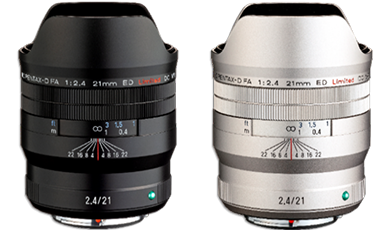
A message from the development team
For more than 20 years since its introduction in 1997, the PENTAX Limited Lens series has been favored by many photographers for its distinctive visual expressions and high-grade exterior design. Now, PENTAX has added the new D FA Limited series to the Limited Lens lineup.
The HD PENTAX-D FA 21mm F2.4ED Limited DC WR has been designed mainly based on numerous sensibility evaluations using actually captured images, rather than numerical evaluations using the latest design-and-simulation technologies.
We’ve brought together personnel from various development sections to talk about their enthusiasm for and devotion to the development of the new D FA Limited series, and asked them to talk about its most notable features.
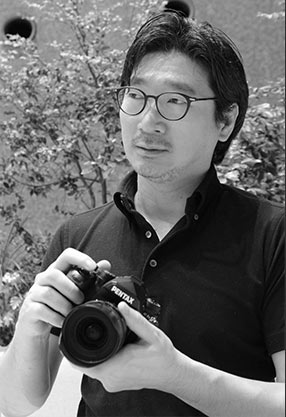 Tetsuya Iwasaki, Product Planning
Tetsuya Iwasaki, Product Planning Yuichiro Ebashi, Optical Design
Yuichiro Ebashi, Optical Design Masakazu Saori, Optical Design & Product Manager
Masakazu Saori, Optical Design & Product Manager Makoto Iikawa, Mechanical Design Manager
Makoto Iikawa, Mechanical Design Manager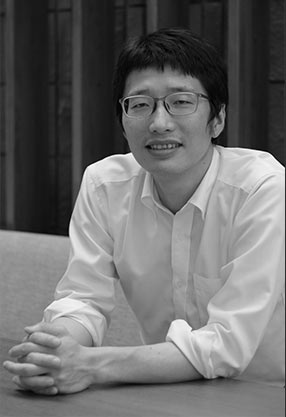 Shoji Nakamura, Mechanical Design
Shoji Nakamura, Mechanical Design Akira Watanabe, Exterior Design
Akira Watanabe, Exterior Design
 Makoto Iikawa, Mechanical Design Manager
Makoto Iikawa, Mechanical Design Manager Shoji Nakamura, Mechanical Design
Shoji Nakamura, Mechanical Design Akira Watanabe, Exterior Design
Akira Watanabe, Exterior Design
Lenses that will retain their charm and brilliance even 20 years from now
[Iwasaki, Product Planning]
The history of the FA Limited series began in 1997 with the launch of the smc PENTAX-FA 43mm F1.9 Limited, a lens now regarded as one of the most distinguished members of the series.
Limited-series lenses are designed to produce natural image renditions that truthfully recreate the ambience and sense of depth of a given scene — elements that can’t be measured simply in numerical values. These lenses assure the essence of superb image rendition, one that holds true over many generations.
PENTAX, which initially ventured into the digital imaging market with a lineup of APS-C-format cameras, launched its first full-frame model, the PENTAX K-1, in 2016. With this launch, PENTAX made it possible for digital SLR camera users to take full advantage of the distinctive focal lengths of the FA Limited-series lenses, which were designed during the film-photography era and boasted a range of innovative and distinguished features.
To further upgrade the crispness and sharpness of images captured by digital cameras, PENTAX later applied its state-of-the-art HD (High Definition) Coating to the 31mm, 43mm and 77mm lenses of the Limited series, and re-introduced them to the market as new-generation models.
To make the world of the Limited series more inspiring and enjoyable, and to make PENTAX full-frame digital SLR cameras more attractive and creative, PENTAX decided to add to the three lenses of the FA Limited series a new D FA Limited series with specifications optimized for digital imaging. In designing the D FA Limited series, PENTAX posed two essential questions: what does the FA Limited series really mean, and what is the essence of FA Limited-series lenses? PENTAX then confirmed the answer: that the Limited series of lenses will retain their charm and excellence even 20 years from now. At the same time, PENTAX redefined the three most important elements of the Limited series.
Based on these elements, PENTAX decided to develop the first model of the D FA Limited series, one providing an ultra-wide-angle focal length not available in the existing FA Limited lineup, and ideal for both scenic and snapshot photography. Unlike conventional ultra-wide-angle lenses producing sharp, high-resolution images at all focusing distances, however, this lens would be designed to capture the main subject in sharp, crisp focus with a mild bokeh (defocused) effect in the background, when set at open aperture in close-up photography. This would make the subject stand out against a mildly defocused background, while still retaining the details needed to truthfully recreate the overall ambience of a given scene.
As a part of the Limited-series lineup, the new 21mm lens clearly demonstrates the distinctive optical characteristics incorporated into the Limited series concept. That’s why its imaging characteristics change depending on the shooting distance and the selected aperture. PENTAX has developed this lens with the hope that users will cherish its distinctive imaging characteristics, and find greater pleasure in digital photography.
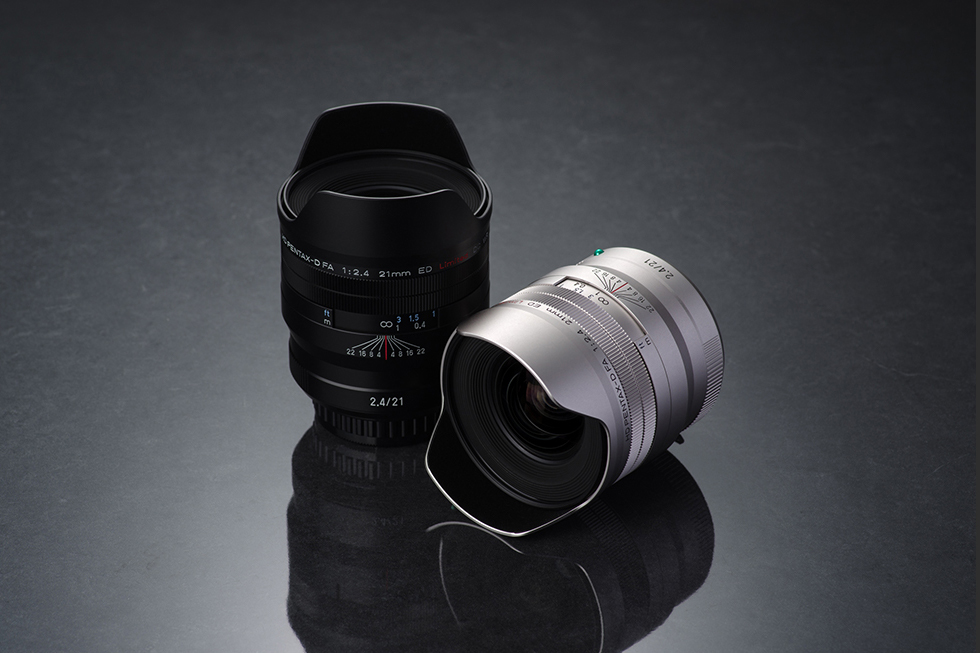
Three most important elements of the Limited Lens series
When assigned to the development of the new D FA Limited series, the development team heard useful stories from several key persons involved in the initial development of the FA Limited series, first launched in 1997, shared old data and reference materials, and collected facts and anecdotes from the past. They formed a group called the Limited Committee whose purpose was to confirm the essential value of the Limited Lens series handed down from past Limited-series lenses, while redefining the three most important elements of the series, described below. These elements apply not only to the new HD PENTAX-D FA 21mm F2.4ED Limited DC WR, but also to all other existing FA Limited-series lenses.
Three most important elements of the Limited Lens series
- ● Creating natural image renditions that faithfully reproduce the ambience and sense of depth of a given scene — essential elements that can’t be measured simply in numerical values
These factors include:
Emphasizing the importance of sensibility evaluations based on actually captured images, and making in-depth assessment of the image renditions of solid objects;
Producing images rich in gradation and with a truthful sense of depth. - ● Making photography more enjoyable:
These factors include:
Changing the visual expression depending on the focusing distance and the selected aperture, while producing natural image renditions with subtle aberrations;
Providing comfortable, flawless manual-focus operation that swiftly responds to the photographer’s intentions;
Realizing a compact size that fits comfortably in the photographer’s hand, and assures a perfect balance with the camera body. - ● Providing joy and excitement of owning and handling a spectacular lens forever:
These factors include:
Creating a sense of stability and precision, assured by the use of metallic material;
Developing an exterior design that is not only simple, but also attractive, well-defined and timeless.
Imaging goals of the HD PENTAX-D FA 21mm F2.4ED Limited DC WR
[Ebashi, Optical Design]
When the Product Planning section contacted us about developing a wide-angle FA Limited-series lens, they gave us their ideas about what they wanted to realize:
- ● A lens that faithfully reproduces the whiteness of the creamy foam of a cappuccino and the ambience of a café with a mellow bokeh (defocus) effect;
- ● A lens that truthfully captures a seashell on the beach with a background of breaking whitecaps and the faraway horizon with a natural bokeh effect;
- ● A lens that visualizes the calm of a forest scene, with beautifully defocused streaks of sunlight;
- ● A lens that clearly defines the details of scenery while faithfully expressing the chilliness of morning haze.
What we most wanted to emphasize was the image description and defocus effect of close-range scenes when the photographer moved in close to the subject with this wide-angle lens. To achieve this goal, we designed the lens differently from conventional models: we intentionally retained a certain level of aberration to create a mild bokeh effect in close-range photography, while creating sharp, crisp images of distant scenery at closed-down apertures. While we were well aware of a mellow image rendition of close-range scenes — a feature common to the Limited Lens-series snapshot lenses — we pursued the sharpness in long-distance scenic photography using a 21mm wide-angle perspective. In the end, we successfully achieved these opposing goals, although it was a long, exhausting road to make them happen. After conducting a series of test shootings by changing the pattern of visual expression and bokeh effect using a trial lens barrel, we shared the test results to the Limited Committee for the process of sensibility evaluation.
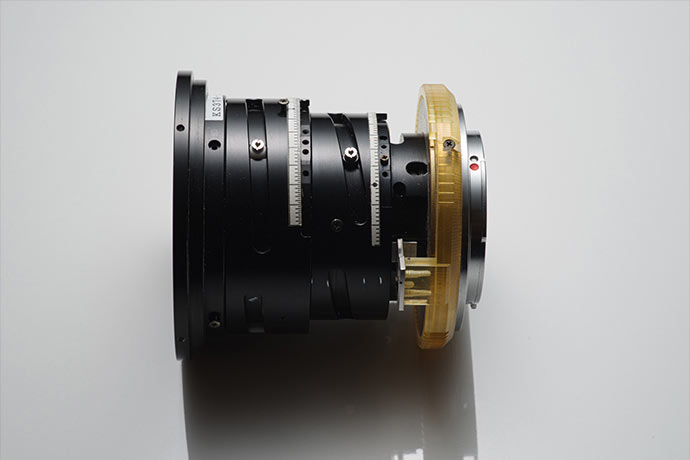 A trial lens barrel actually used in test shooting. This specially designed model allows the adjustment of the bokeh effect level according to the position of the optical elements.
A trial lens barrel actually used in test shooting. This specially designed model allows the adjustment of the bokeh effect level according to the position of the optical elements.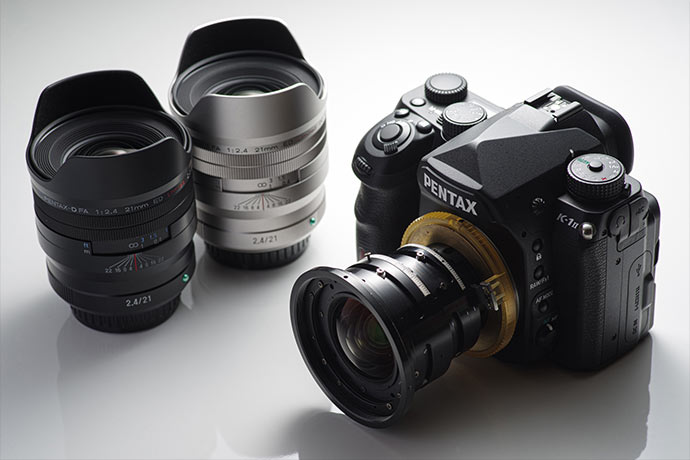 A trial lens barrel, along with the product versions of the HD PENTAX-D FA 21mm F2.4ED Limited DC WR
A trial lens barrel, along with the product versions of the HD PENTAX-D FA 21mm F2.4ED Limited DC WRSuperbly controlled spherical aberration for ideal visual expression
One of the adjustments we made in response to the test shooting results was to control the level of spherical aberration. In close-range photography using open and larger apertures, spherical aberration was intentionally increased by a considerable level to produce a soft-focused image in which the in-focus plane in the image field appeared to be rather vague and indiscernible. If the adjustment became too excessive, however, the image would appear completely blurred. To avoid this problem, we adjusted the level of spherical aberration bit by bit in test shootings until we discovered the optimum level, one that assured the imaging characteristics close to our imaging goals. The final decision was made by the Limited Committee following its sensibility evaluations.
However, the lens wasn’t designed to produce soft-focused images at all aperture settings. Anticipating that photographers might also prefer to close the aperture down in scenic photography, we designed the lens to produce rather crisp-focused images when the aperture is closed down to F4 or smaller.
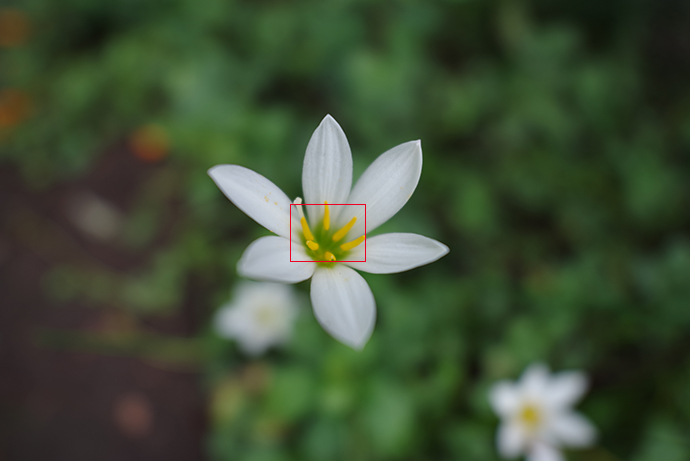
 F2.4
F2.4 F4
F4The pursuit of circularity in bokeh shapes and the suppression of color bleeding
Thinking about ensuring the mellow appearance of defocused areas, we worked on the quality of these areas by ensuring that the elements affected by coma aberration would appear circular, and by minimizing fuzziness in the affected areas. We also paid special attention to retain the circularity in the defocused background surrounding the main subject, and tried to reduce the color bleeding of defocused elements to an undetectable level. We even repeatedly conducted a verification process to find the acceptable level for the bokeh effect in the medium- to lightly-blurred areas in the background, while suppressing flare to a minimum. When spherical aberration was reduced, focusing operations became easier because of the lack of flare. Excessive compensation, however, resulted in boring, undistinguished images.
We can’t make a complete assessment of each lens’s distinctive imaging characteristics through the use of a simulator. We believe that it’s extremely important to conduct sensibility evaluations with the human eye in the development of Limited-series lenses.
[Difference in the shape of
defocused elements]
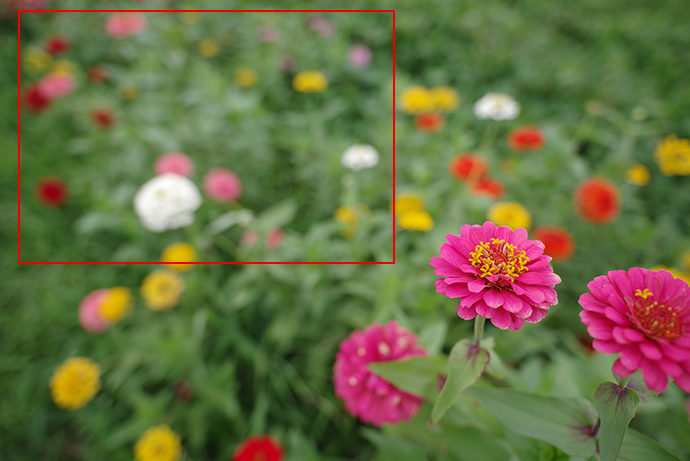
 Taken with HD PENTAX-D FA21mmF2.4 ED Limited DC WR (F2.8)
Taken with HD PENTAX-D FA21mmF2.4 ED Limited DC WR (F2.8) Taken with 20mm lens (F2.8)
Taken with 20mm lens (F2.8)Mechanical design, and developing an original 21mm cam
[Iikawa, Mechanical Design]
In our standard procedure, we finalize the optical design before moving on to the mechanical design. In developing this new lens, however, we worked simultaneously on both mechanical and optical design, because we decided to prioritize test shooting results before making the final decision on the optical design and image rendition. This meant, though, that we anticipated delays in the mechanical design, because the lens’s drive trajectory couldn’t be determined until the last moment. That’s why we took a different approach to solve this issue. First, we moved ahead with mechanical design as soon as the optical design team calculated the maximum movement of the optical element groups that would affect the lens’s optical performance; we simultaneously conducted verification of the lens’s drive trajectory and the mechanical design process.
During the process of determining the position of the taking lens, we also had a hard time designing the driving cam that would regulate the position of the optical element groups. If we put priority on the image renditions obtained from actual test shootings, we found points where the cam’s movement within its drive range was considerably greater. Since this would affect both the lens’s operability in manual-focus operation and the design of the autofocus mechanism, we had to repeatedly revise the relationship between the optical design and the cam design. While prioritizing the test shooting results, we finally developed a cam design that wouldn’t compromise manual-focus operability or autofocus accuracy.
Mechanical design assuring smooth manual-focus operation
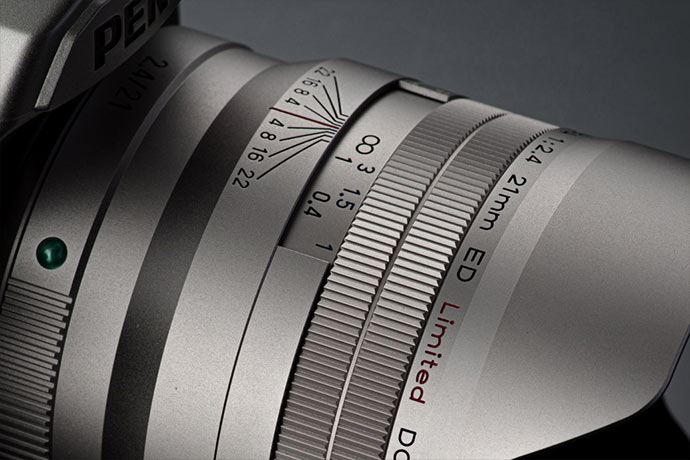
[Nakamura, Mechanical Design]
From the start of the development process, we wanted to improve manual-focus operability and assure a direct shift to manual-focus operation. That’s why we decided to use the Quick-Shift Focus System, which was also incorporated in the HD PENTAX-DA 20-40mm F2.8-4ED Limited DC WR.
Because this innovative mechanism links the AF lens driving parts directly to the MF regulating parts, we could optimize the mechanical design by adding the torque fluctuations caused by the shape of the lens driving cam — a factor that determined the lens’s distinctive image rendition — to the AF driving torque, MF regulating torque and torque load of the sealing parts used for weather-resistant construction. To optimize the performance of this mechanism, we introduced a new torque detection process, while adding a torque management process to access not only maximum and minimum torque levels, but also torque fluctuations.
High-precision operation of autofocus system
In combination with the new torque management process mentioned above, we introduced a sensor unit that directly detected the movement of the cam parts that regulated the lens’s drive action. We also introduced another sensor unit that detected the backlash caused by friction between the driving motor, switching clutch and lens driving parts. These units made a great contribution to the improvement of autofocus accuracy. Although a movable cam is normally incorporated to prioritize the image renditions, it can affect the performance of the AF driving mechanism. By adopting an original algorithm, however, we were able to design the AF mechanism without compromising on autofocus accuracy.
Our efforts have resulted in highly precise autofocus operations, while assuring outstanding weather-resistant performance and smooth focus operations.
Shippoyaki mount pointer: the symbol of the FA Limited series
The raw materials used have changed over the years since the launch of the FA Limited series, and the shippoyaki (cloisonné) mount pointer has also seen a change in tone. Although this change reflects the charm of shippoyaki, we wanted to make the new lens’s shippoyaki mount pointer as close in tone as possible to the original one. That’s why we asked a shippoyaki artist — a dependable partner since the days of the first FA Limited series — to formulate a new glaze for the new D FA Limited series. Starting with this new series, this new shippoyaki part will become a standard fixture of the PENTAX Limited series.
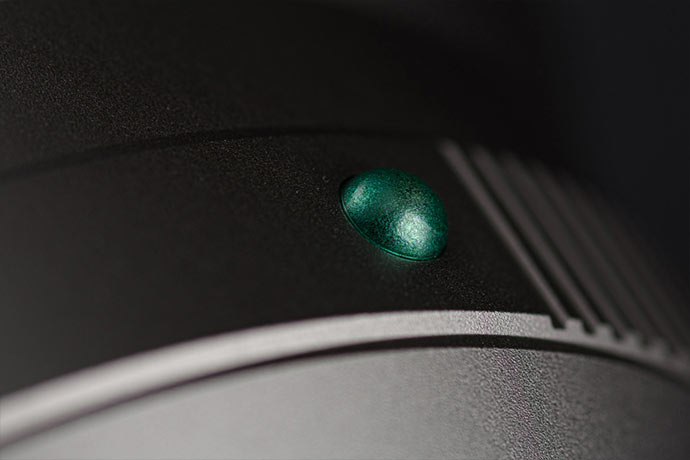 Shippoyaki mount pointer, with a tone identical to the original
Shippoyaki mount pointer, with a tone identical to the original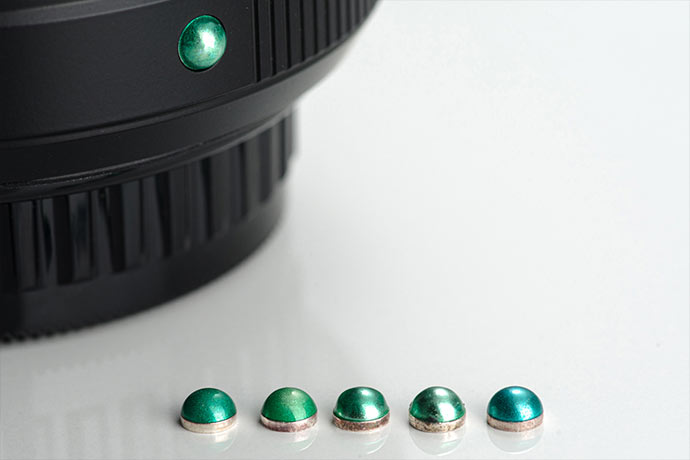 Samples of shippoyaki mount pointer: (from left to right) final version; newly formulated glaze over sterling silver; current glaze over bronze; current glaze over sterling silver; and older glaze over silver alloy material
Samples of shippoyaki mount pointer: (from left to right) final version; newly formulated glaze over sterling silver; current glaze over bronze; current glaze over sterling silver; and older glaze over silver alloy materialCircular diaphragm with even-numbered blades for beautiful beams of light
We designed a new diaphragm unit exclusively for this new lens. To produce a mellow bokeh (defocus) effect at open and larger apertures, this unit incorporates a circular diaphragm mechanism. To create beautiful beams of light in nightscape photography, it consists of an even number of aperture blades. I hope that users will enjoy the superb image rendition in capturing distance scenes at closed-down apertures. Although it’s often the case that diaphragm mechanisms generate ghost images that may compromise image quality, we were able to minimize the generation of ghost images by applying an anti-reflection coating to the lens interior.
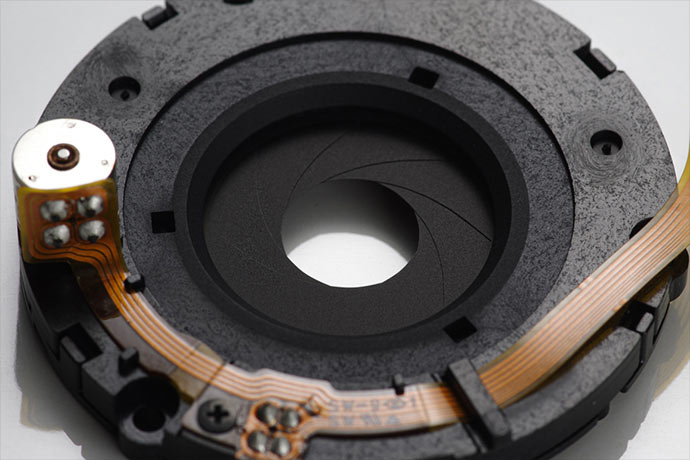 Aperture unit
Aperture unitOmomuki (tastefulness): the design concept of the Limited Lens series
[Watanabe, Exterior Design]
The most important design concept of the Limited Lens series for the exterior designers is omomuki, or tastefulness.
Once you hold a Limited-series lens in your hand, you’ll want to keep it close for many years to come, and to look at and touch it at every possible occasion. It will entice you to go out and capture images. That’s the kind of lens we hoped to develop.
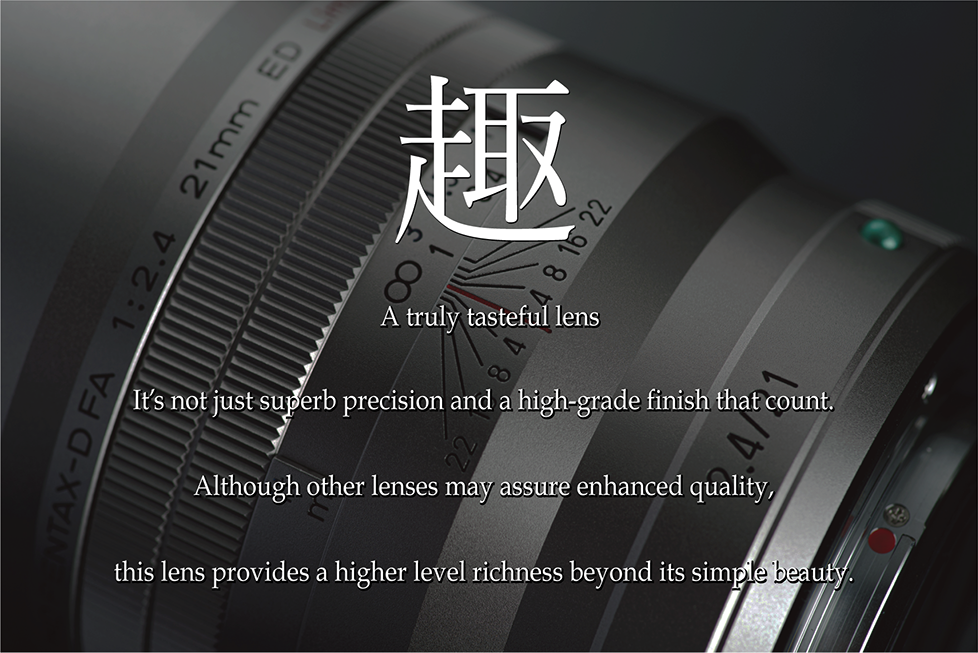
What is a tasteful lens?
- Appearance
- A compact size and a pleasant shape, a high-grade texture and a sense of solidity assured by the use of metallic material, and remarkable precision made possible by meticulously machined parts.
A highly condensed design with the utmost attention paid to every detail, and parts with a tone that is neither inorganic nor monotone.
Rich, tasteful exterior design.
An exterior appearance that exhilarates you when holding and touching the lens. - Features
- Smooth, flawless operation of the focus ring.
A lens cap that instantly activates the camera when removed.
Excellent operability identical to both older and newer lenses,
and quiet, responsive focus operation. - Concept
- Imaging performance that goes beyond numerical measurements,
and sensibility evaluations based on actually captured images.
A focal length that can tell a photographer’s story.
A truthful sense of depth similar to the image seen by the naked eye.
A key phrase that represents the product concept of each lens. - Imaging performance
- Reproduction of the natural, truthful ambience, rich in gradation.
Distinctive image rendition of each lens, visualizing the story behind every image.
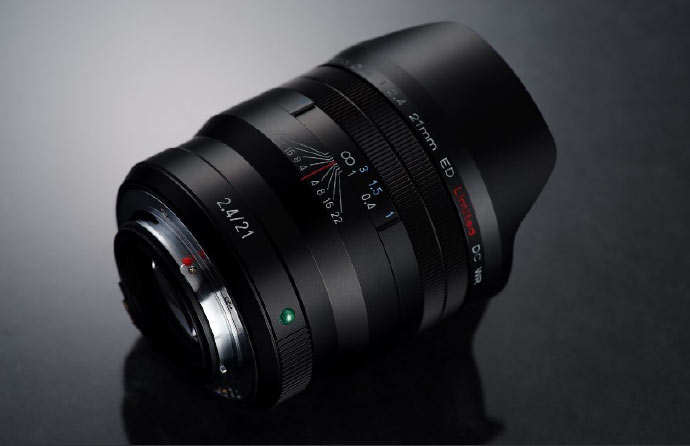
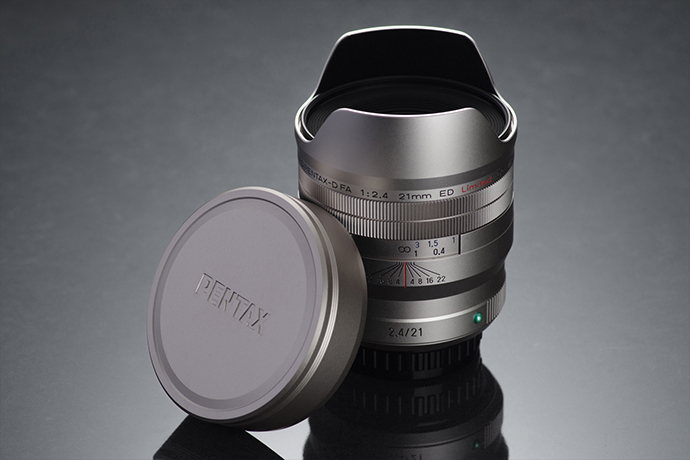
The final message
Even after more than 20 years since its launch, the PENTAX FA Limited series is cherished by many users as the representative of PENTAX interchangeable lenses. When we first decided to develop the D FA Limited series, we had to reconsider what the FA Limited series really was by reviewing, rethinking and questioning every aspect of this lens series.
We reached the conclusion that the identity of the series came from the never-changing pleasure of photography using interchangeable lenses. Light traveling through the optical elements and the diaphragm produces an image that faithfully depicts the ambience and sense of depth of a given scene, and precisely visualizes the beauty felt by the photographer. The FA Limited series of lenses embodies our conclusion.
We wanted to create lenses that entice users to go out and take pictures.
In the ongoing development of PENTAX interchangeable lenses, the D FA Limited series has been a tremendous challenge for us. That’s why we sincerely hope that our users will enjoy using them, as well as the FA Limited series.
An ultra-wide-angle lens, delivering
distinctive image
renditions in both close-range and distant photography:
creating a natural, beautiful bokeh (defocus) effect for subjects such as a seashell on the beach with a background of breaking whitecaps and the faraway horizon
HD PENTAX-D FA 21mmF2.4ED Limited DC WR
